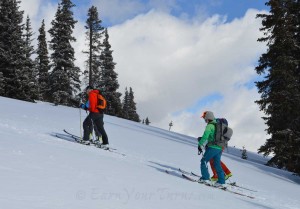To say that next year’s new skis from Dynafit are probably the best turning skis they’ve ever made only confirms what backcountry skiers have known for years; there’s a limit to how light you can make a ski if you want great downhill performance in a lot of conditions, at any speed. In short, when you’re harnessing gravity, not wrestling with it, weight is great.
During a day of skiing mostly packed runs at Alta ski resort the Chugach did what no other Dynafit ski had ever done, held a solid edge, nay, even had the ability to carve a turn on scraped-off, ski polished slopes. Other, lighter weight skis have held an edge, but not carved like the Chugach can.
As is often the case, you don’t know what you’ve got ’til it’s gone. After a few runs on the Chugach it was time to change skis and try another pair. For the rest of the day I did my darndest to get back on the Chugach, but alas, the rest of the day was spent compensating for the hooky response of a pair of lighter weight Denali’s. It wasn’t until two weeks later I had a chance for a rerun.
Much of the performance of the Chugach is rooted in having enough mass to push back when the snow isn’t the puffy, fluff of dreams. The smallest pair of Chugach weighs it at a solid 4+ pounds per ski. There may be exceptions to the rule, and ski manufacturers like Dynafit have done an amazing job of trading stiffness for weight but in the end if you demand downhill performance in the more common, heavier varieties of snow, you need mass behind the muscle of a ski. Dynafit’s know-how in making due with less benefits the Chugach by using just enough carbon to enhance torsional stiffness with a smooth flexing ash-poplar wood core, the true heart of the Chugach’s predictable performance. That isn’t all though, as the ski has a smooth, early rise tip to lift the ski up whether breaking trail or charging through crud. The tail has just enough rocker to release out of a turn in deep snow, but not so much that you can’t hold on to a turn on hard snow, giving a nice rebound into the next turn when you’re ready for it.Thus, on firm snow it can carve at speed, and it simply plowed through crud as any fat, mid-weight ski ought to. While eight pounds seems hefty compared to some of the carbon skis on shelves, it isn’t a heavy ski compared to alpine skis with metal topsheets. With a pair of Dynafit bindings you can keep your weight per foot to under 10 pounds; and depending on the boot you pair it with, maybe even under eight pounds per foot (skis, skins, bindings and boot).
On a short tour at Berthoud Pass with the Dynafit crew I noticed the extra weight of the Chugach rig compared to my go-to rig, but most of the difference boiled down to an extra 20mm of width throughout the ski. That extra width was a definite advantage for flotation on eight inches of cold, light, untracked pow. There were no complaints with regard to skinning efficiency, and none when turning. Available Fall 2015.
Dynafit
Chugach
MSRP: $800
Dimensions:
173cm | 134-106-124mm | 1850 g | 20m
181cm | 135-107-125mm | 1950 g | 22m
188cm | 136-108-126mm | 2050 g | 24m
193cm | 137-109-127mm | 2150 g | 26 m
© 2015



1 pings